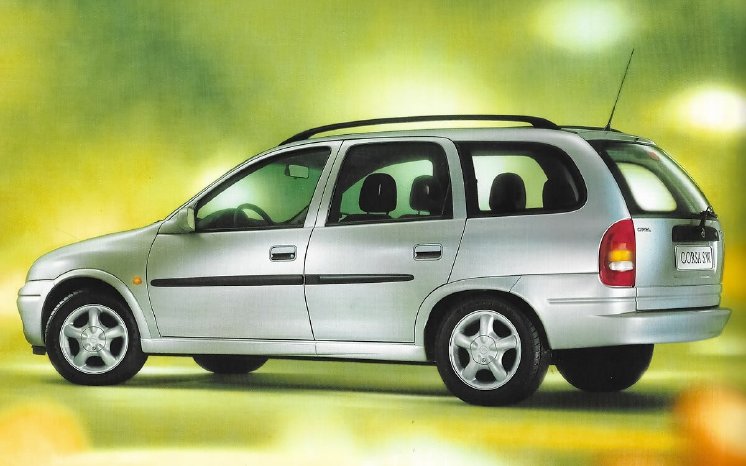- 1993 until 2000: Second Corsa generation continued success of best-selling small car
- Safety benchmark: Corsa B was first in class with double door beams and seatbelt tensioners
- Pocket rocket: Corsa GSi with 80 kW/109 hp, sports chassis and sharp styling
- Start of new era: Second generation Corsa was first to be “made in Eisenach”
- Fun to drive goes electric: Locally emissions-free new Corsa Electric in two power outputs available now
This applied especially to the second Corsa generation. After the breakthrough of the Corsa A, introduced in 1982, it went one step further when it was launched exactly 30 years ago. With an independent design and features that set safety standards, as well as a high level of comfort and practical benefits, it celebrated worldwide success and even cracked the four-million mark in sales by the year 2000. In addition, as of 1993, the Corsa B opened a new era as the first Corsa “made in Eisenach”.
Rounding the edges: Corsa B-variants variants with new styling cues
The designers led by Hideo Kodama took a risk with the successor to the first Corsa. Despite the great success of the angular Corsa A, the decision was made in Rüsselsheim to make the Corsa B more appealing to women. So Kodama got to work and designed a much rounder, softer Corsa, whose headlights looked like large eyes. The smooth, rounded shapes were inspired by the Junior concept car, which had caused a stir a few years earlier. But the softly flowing contours also had a practical effect: they improved aerodynamics and thus reduced fuel consumption.
Also noticeable was the different design of the three and five-door models. The designers had practically created two models with their own character. They gave the three-door model a sporty silhouette with a coupé-like rear, while the five-door was the “family” variant with a more upright tailgate. The rear was more spacious for the passengers in the second row and the luggage volume increased to a maximum of 1,150 litres.
The Corsa B especially stood out with its wide range of variants. Five equipment levels from Eco to Swing, Joy and Sport to the GSi offered something for every taste, also thanks to the matching fabric patterns and colours. In addition, Opel complemented the three and five-door hatchbacks with an estate, a four-door notchback and even a pick-up for certain markets.
Benchmark for comfort and safety: Corsa B set standards in its class
The further development from generation A to B also benefited comfort and, above all, safety. The Corsa grew by 10 centimetres to almost 3.73 metres in length, had a longer wheelbase and extremely short body overhangs. In addition, the windscreen had been pulled further forwards and the rear of the five-door model sloped down at a steep angle. All these measures enabled the Corsa B to offer the best values in its class in terms of space and freedom of movement (head, shoulder and leg room). Large windows and narrow pillars created a light, airy interior atmosphere and enabled good all-round visibility. In order to ensure a clear view from all sides, even in bad weather, a special windscreen surround on the sides kept rainwater away from the windows; the aerodynamically designed exterior mirror housings also had a small lip that prevented the accumulation of dirt on the mirror surface and the windows.
The second Corsa generation set new safety standards in the small car segment. The torsional rigidity of the body had been increased by 40 per cent compared to its predecessor. For the first time in this class, double steel beams in the doors, offering passengers additional protection in the event of a side impact, and mechanical seabelt tensioners on the front seats, were fitted as standard. Height-adjustable seatbelts at the front and rear as well as anti-submarining ramps in the seat frames were other important safety features of all Corsa models. And shortly after the launch, a full-size airbag for the driver was also available.
Opel’s little sportscar: The fun-to-drive Corsa GSi
A particularly sporty variant hit the road in 1993, the Corsa GSi 16V. The sportiest Corsa of the time featured colour-keyed side-sills and bumpers as well as front and rear spoilers. The standard equipment also included electronically-controlled ABS, a rev-counter and wide tyres.
The Corsa GSi could sprint from zero to 100 km/h in 9.5 seconds and reach a maximum speed of 195 km/h. A sporty chassis and gas-filled shock absorbers helped to bring the performance onto the road. Sports seats and a leather-trimmed steering wheel created the right atmosphere in the cockpit.
Fun with responsibility: Resource conservation was built into the Corsa B
At the same time, Opel showed even then that driving pleasure goes hand in hand with responsibility. Sustainability and resource conservation has always been a focal point of development for the brand with the Blitz.
The second Corsa generation set the benchmark here too, thanks to its efficient petrol engines with fuel injection and catalytic converters. With its particularly economical 1.2-litre engine (33 kW/45 hp), the Corsa already met emission standards in 1993 which came into force only three years later. And with an average consumption of 4.66 l/100 km, the Corsa Eco was “Europe's most economical car” in terms of weight and performance according to the ADAC and the ÖAMTC. In addition, with a pass-by noise of just 72 decibels in the early 1990s, it was also one of the quietest cars in Europe.
In 1990, Opel was the first car manufacturer with a recycling loop for automotive plastics. The subsequent recycling of end-of-life vehicles was therefore already considered during the design of the Corsa B. Unmixed plastic composites and easy-to-dismantle fastening techniques for individual components made an important contribution to environmentally compatible recycling. With the start of production at the Eisenach site 30 years ago, the Corsa was produced at one of the most modern and resource-efficient automobile plants in Europe.











